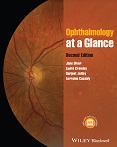- Home
- Cases
- Flashcards
- Figures
- Your feedback
- Become a reviewer
- More student books
- Student Apps
- Join an e-mail list


A 36-year-old general practitioner (GP) was seen in eye casualty with sudden, unilateral, painless visual loss. She blamed stress as she was still recovering mentally from her fourth miscarriage in 2 years. Her VA was 6/9, she had no relative afferent pupillary defect and dilated fundoscopy revealed widespread haemorrhages in all quadrants, but no cotton wool spots.
1. What is the most likely differential diagnosis?
2. Why could this have happened to this young woman?
After you explained the diagnosis, she wanted an FFA and laser treatment today.
3. Why is this not the correct management regime? Is there any evidence that you could quote?
Three months later in clinic, her VA was 6/18, her intraocular pressure was 14 and there was no evidence of rubeotic vessels. OCT revealed macular oedema. She had been reading around the subject and was reluctant to have monthly injections.
4. Is there anything else you can offer her to improve her vision? Is this an established mode of treatment?
5. Is there any other medication you could prescribe in the long term?
Five years later she comes back with ischaemic changes in the posterior pole. She also has rubeotic glaucoma and no visual potential.
6. Are there any maintenance medications she can have to keep her eye comfortable?
Please refer to the vein occlusion chapter (Chapter 47) for further information.